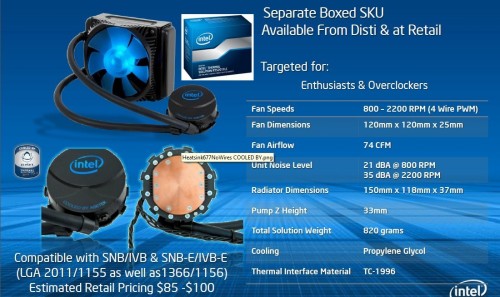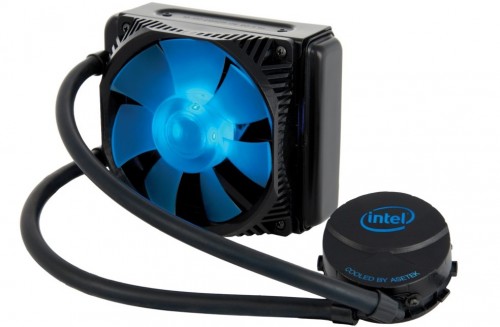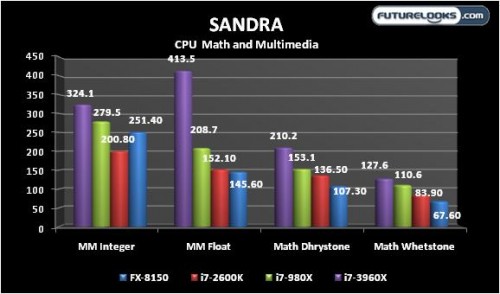New Liquid Cooling Available
The last couple processor launches have come with some various CPU cooler alternatives. Unfortunately, those coolers just didn’t indicate that there is an extreme edition processor underneath. Asetek and Intel got together to offer an after market all in one liquid cooler (RTS2011LC) that does that and shows a little Intel love at the same time. This badged cooler can be optionally purchased between $85 and $100 US/CA from distributors and retailers.
If a badged unit isn’t what you want, there are also other LC systems available from Antec, Coolermaster, Coolit Systems and Corsair. Many are similar in design yet make many air coolers look down right boring. Plus, many of them are quieter than Intel stock coolers. The unit I have here has been a pleasant experience thus far.
Test System and Configuration Notes
As with any CPU launch, I’ll be comparing Sandy Bridge-E performance to previous generation processors. In part two, we’ll open a can of whoop-a$$ on the motherboards to see who has their fingers on the pulse of the computer enthusiast market. Here is the break down of the test systems.
Test System 1
- Processor: Core i7-3960X Sandy Bridge-E
- Motherboard: Intel DX79SI Extreme
- Memory: Kingston HyperX Genesis 16GB Quad Channel @ 1600MHz (CAS9)
Test System 2
- Processor: Core i7-2600K Sandy Bridge
- Motherboard: ASRock Z68 Extreme 7 Gen 3
- Memory: Kingston HyperX Genesis 4GB Dual Channel @ 1333MHz (CAS9)
Test System 3
- Processor: Core i7-980X Gulftown
- Motherboard: ASUS Rampage III Black Edition (X58)
- Memory: Patriot Memory Division 2 12GB Triple Channel @ 1333MHz (CAS9)
Test System 4
- Processor: AMD FX-8150 Bulldozer
- Motherboard: GIGABYTE GA-990FXA-UD5
- Memory: Patriot Memory Division II 4GB 1866MHz (CAS9)
Shared Components:
- Graphics: 2 x MSI GTX 560 Ti Hawk Edition
- Power: Antec TPQ-1200 (1200 Watt)
- Storage OS: Seagate 500GB SATAII
- SATA2 and SATA3 Test: Kingston HyperX 120GB SSD
- OS: Windows 7 Pro 64-bit
Naturally, the latest motherboard BIOS, INF driver file and NVIDIA drivers were used in tests. The OS is fully patched across each platform. Intel Turbo Tech was enabled on all platforms since it’s a built in CPU feature. Thermal core throttling was disabled to eliminate this as a penalizing variable.
Preliminary Overclocking
I gave the Core i7-3960X a test run on the Intel DX79SI motherboard to see where it stops. Preliminary attempts revealed that Sandy Bridge-E’s clock generator to be external, meaning you can push the Bus Clock (BClock) without pushing the rest of the PCIE sub systems. Plus, as you change the memory strap, you can utilize different memory frequencies as you push the BClock. If you recall, one of the DX79SI’s board specs is 2400MHz DDR3 overclocked support which was easy to reach with the proper settings.
Ultimately, the board wouldn’t give me anything higher than right at 4.7GHz. Keep in mind that temperatures started to heat up pretty quickly on the single radiator Intel liquid cooler. It wasn’t really too loud at all at full speed. The thing to keep in mind is that it will quickly heat up in much warmer climates. Such is the case with all compact liquid cooling systems.
Since any processor overclocks differently on different motherboards, your results will definitely vary. Unfortunately most our boards came a little too late in the process to roll out a detailed overclocking comparison.
Benchmark Suite Notes
SANDRA – Mathematical and Multimedia
The 3960X enjoys a hefty boost in both computational and multimedia benchmarks. The FX-8150 surprised me in the Integer score which could be reproduced. The Core i7 series essentially dominate the mathematical scores.
SANDRA – Cryptography
The trend basically continues here with the Core i7 just about leading with the exception of the FX-8150’s bandwidth. The point that should be made is that the Core i7-3960X blasts past previous generations. The poor Bulldozer is on the verge of looking really sad.





